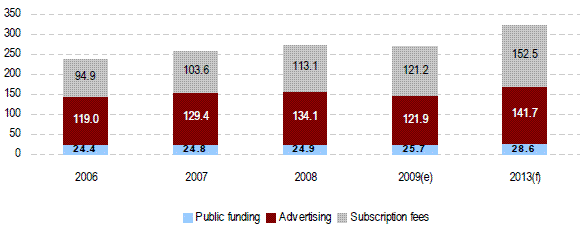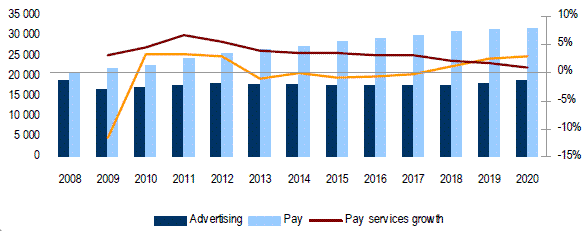 TV Market Data /
World Television Market (2008-2013)
TV Market Data /
World Television Market (2008-2013)
April 2010 |  IDATE IDATEGlobal TV 2010 - Markets, Trends Facts & Figures (2008-2013) The World Television Market in 2009 represents a total amount of 268.9 billion EUR, declining 1.2% compared to 2008. According to iDate's report, the worldwide television market was, in 2009, primarily affected by the decline in advertising revenue of 9.2%, which could not be compensated for by paid television or public funding; these two sources of revenue increased 7.2% and 3.5% respectively. Up until 2008, advertising was by far the primary means of funding for the industry, generating about 50% of the sector's revenue, compared to 40% for paid television and 10% for public funding. In 2009, the weight of advertising and subscriptions each accounted for about 45% of the sector’s revenue. By 2010, revenue from paid television should exceed overall advertising revenue worldwide, reaching a ratio of approximately 47%/44% by 2013. "Industry did not escape the consequences of the global economic crisis; the crisis particularly affected television advertising revenue. Nevertheless, IDATE predicts that the market will exceed its 2008 level in 2010", comments Florence Le Borgne, project leader of the World Television Markets report.
Evolution of TV revenue around the globe by type of financing, 2006-2013
Despite the fact that it is weathering the economic crisis rather well, pay TV will need to evolve in the short
term as a result of a host of factors, mostly related to technology, competition and consumption patterns.
Faced with competition from more multichannel free-to-air offerings on DTT and the success of videosharing platforms, pay channels must work even harder to offer value-added programming and services to build subscriber loyalty and attract new customers. Theme channels have the weakest business models and therefore are the most threatened. As video consumption becomes increasingly independent of a TV schedule, pay-TV operators are gradually implementing solutions to meet viewers’ need for flexibility and personalization. These services act as additional sources of revenue for these operators.
The predicted development of
All the conditions for the
 video services. This offensive strategy will likely pay off
down the line, but does not entirely eliminate the possibility of destroying value. There are structural
reasons for this, including a fiercely competitive online advertising market and a lack of control over
program circulation. video services. This offensive strategy will likely pay off
down the line, but does not entirely eliminate the possibility of destroying value. There are structural
reasons for this, including a fiercely competitive online advertising market and a lack of control over
program circulation.Far from being simply transitory, the 2009-2010 economic downturn marks the beginning of a decade of restructuring for the TV industry. This new period will begin with an overall decline in the sector’s resources before increasingly varied consumption patterns spur a new period of growth. The decade running from 2010 to 2020 will also be a period that focuses on cost control, with the industrialization of TV production that will depart once and for all from its historical model, i.e., film.
The total TV/video market in the EU big five, 2008-2020
Or visit
Related Resources:
____________________________________________________________
____________________________________________________________
____________________________________________________________
____________________________________________________________
____________________________________________________________
____________________________________________________________
____________________________________________________________
____________________________________________________________
____________________________________________________________
____________________________________________________________
____________________________________________________________
____________________________________________________________
____________________________________________________________
____________________________________________________________
____________________________________________________________
____________________________________________________________
____________________________________________________________
|
© 2007-2010 by itve.org | search | legal | contact | supported by:







 Global TV 2010 - Markets, Trends Facts & Figures
Global TV 2010 - Markets, Trends Facts & Figures